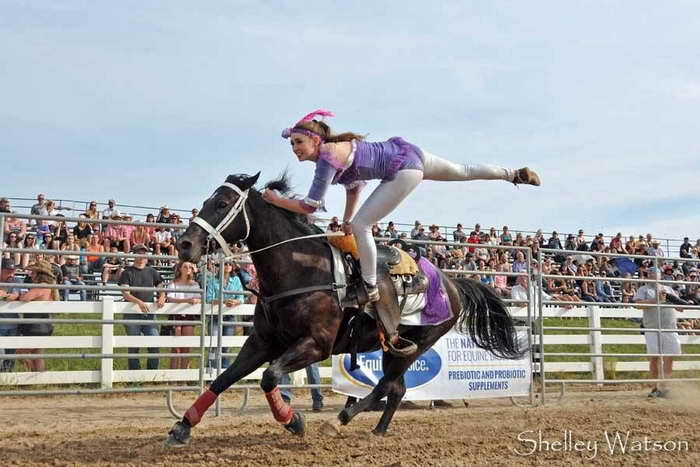Trick Riding is Being a Daredevil on a Horse
A crowd has filled the seats ringing an outdoor riding arena. At one end of this arena, in a sort of staging area, stand a number of horses with their riders decked out in red and white uniforms. They are the Canadian Cowgirls, a horse-riding demonstration team from Chatham, Ontario. One of the riders is Kylee Nevills, an 18-year-old from Southwestern Ontario.
Listening closely, it’s possible to hear her give a short “Go on!” to her horse, Apache. He likes to run, so it’s all the urging he needs as the pair take off along the fence line. Following a path bounded by the arena fencing, Apache has immediately gone into a thundering gallop that will take them in one complete circuit around the arena. The strength and speed of Apache is awesome to see. Suddenly, Kylee drops down out of her saddle, legs draped over the horse’s neck, her head inches from the ground. You can hear gasps in the crowd. But this is Kylee’s “normal”. Kylee, you see, is a trick rider.
Hers is not the classic tale that plays out like a Hallmark Movie. That story of a young girl and her pony, growing up and riding through life together, the horse a constant companion. Well, that’s sort of Kylee’s story, but not really. Instead, picture a young girl who, from her first pony, wants to ride faster and faster. And oh, by the way, she wants to perform tricks, too. Sure, riding across the countryside is a wonderful experience, but nothing will beat the rush of being on the edge of control and inches away from injury.
Neither her upbringing nor her bubbly personality hint at the streak of daring-do that runs through this middle daughter. Her life has been rooted in family, tied to each other and to the land that previous generations have worked. Kylee says of the farm she lives on, “This farm has been in my family for quite a long time. Our house used to be my great grandparents’ house.” The family farm grows cash crops. She explains, “Mainly just corn, beans and wheat that we grow, but we also do have a hayfield for our horses. Of course we have horses, but then we have goats now, and dogs and cats. But that’s pretty much it, animal-wise.”
Both of her parents had owned horses in the past, so perhaps it was natural for Kylee to follow in their footsteps at seven years old. “I got my first pony from TJ Stables”, she says. TJ Stables is an award-winning equine facility located in Chatham-Kent. “Since my parents had some knowledge of horses and I was still pretty young, I would just ride around the farm and the pastures and fields and stuff like that. Take care of the pony, brush it, all that kind of stuff. When I was seven, when I first got the pony, it was mainly just my parents helping me out but when I turned eight I started doing lessons at TJs.
The Trick Riding Desire Starts Early
“Back then I just used one of their horses and I of course had my horse at home. Eventually, when I started to outgrow that pony, I ended up selling that pony back to TJs, and then I bought another horse.
“It’s pretty common for people to sell their horses that they outgrow,” Kylee explained. “You can outgrow a pony, size-wise. Or say your skills are developing and growing and your pony is just not at what your skill level is now. I needed an upgrade! She goes on, “My pony, I’ll be honest, I was definitely a little bit scared of it. It threw me off a couple of times and I didn’t like that too much. Of course, it was a little bit hard, I’d had the pony for a couple of years. But I definitely was a little afraid of it, so it wasn’t difficult.”
The movement of horses between riding stables and other owners is quite common, according to Kylee. Places like TJ Stables do their best to ensure that horses go to places where they will be well taken care of. Over time, it is natural for a previous owner to lose touch with the location of the horses that they have sold. However, sometimes they can come back into a rider’s world in mysterious ways.
This leads Kylee to relate a story that stands out from her time of traveling to various riding events, and it is something she can’t fully explain. “When I sold [the pony] back to TJs they sold it to another horse riding barn, where people would take lessons on the pony.” Kylee hesitates a moment and then says, “I don’t know if you believe in stuff like this or not– a couple of years ago we were at a horse show…and there was an animal reader-type person there. One of my friends was getting her horse read by this person. And out of nowhere she’s like, ‘did anybody in here used to have a little bay pony thats name started with the letter D?’ I was like, Oh, I did!. But this is kind of weird, this is random, where is this coming from?
“I guess my pony had actually passed away. And, apparently, it was there, and the animal communicator wanted to let me know that the pony was ok. He wasn’t in any pain anymore. It was pretty creepy, a very overwhelming experience. I never told her anything about that [pony]. It came out of nowhere.” While the majority of her riding experiences don’t involve the supernatural, that one incident still brings chills.
TJ Stables, where Kylee has spent years taking riding lessons and eventually graduated to teaching lessons to young riders herself, is home to the Canadian Cowgirls. The team has ridden at major events such as the Indy 500 Festival Parade and the Calgary Stampede. For those who spend time at the stables, members of the Canadian Cowgirls are often there, tending to their horses and practicing. They are heroes to the young riders. The owner of the stable, and founder of the riding team, Terry Jenkins, is also very hands-on and visible around the property. Right from the start, Kylee took notice of the team members; in particular, that some of the horse and rider pairs were performing tricks.
At first, Kylee was interested in Vaulting. Kylee explains it, “Vaulting is someone standing in the middle of the arena, and they have the horse on a lunge line, which is just a long rope. The horse is circling around the person. If you are vaulting, you are doing maneuvers on top of the horse. It’s basically like dance and gymnastics put together on top of a horse. You’re on top of the horse doing different moves.
“I always really wanted to try vaulting, which is kind of like trick riding, but I guess it’s a little more precise. It’s definitely a lot more pretty and slow. TJs always had vaulting lessons when I was taking lessons. Since I was so young, my parents weren’t really thrilled with the idea of me doing tricks on the horses.” Over the years, as she developed her riding ability through lessons, she was constantly surrounded by the ever-present members of the Canadian Cowgirls, and she aspired to one day become part of the team. A dream that was eventually realized and, with it, the opportunity to become a trick rider.
Canadian Cowgirls Open the Door to Trick Riding
“Typically, when you join the team, you have to wait one full year before you can learn how to do any sort of trick riding,” Kylee relates. “But they had a show coming up and they needed more trick riders so I just kind of jumped into it and started learning. Some of the girls on the team, and of course Terry, helped me out. At first, I tried to get into it with Apache, but he was very young at the time, so he didn’t have the mind for it quite yet. I learned on my friend’s horse and went to a couple of shows on him until I got my horse ready. I’ve just kind of been hooked ever since I guess.”
Even though her initial trick riding training time was compressed, it still happened in a safe and orderly fashion. “When I first learned, we started off doing static tricks, so that means your horse is standing still and you’re learning the tricks while the horse isn’t moving. Someone’s holding your horse, someone’s helping you. Terry and my friend on the team showed me three tricks. I practiced those three tricks standing still. Since I was using my friend’s horse, that horse was already patterned for the trick riding pattern, so I didn’t have to teach him to follow the wall.
It was just me that really had to learn. After I got those tricks at a standstill, I had to learn how to do them at a walk. Of course, you have to [follow] safety precautions. That was a very big thing. We spent a lot of time learning safety because if you can’t be safe, or don’t know how to be safe during trick riding, that’s not a good thing. Safety is number one. Of course, after I was comfortable at a walk, [I] went to a trot, then to a canter.” Eventually, the rider works their skill level up to perform the tricks while the horse is at a full gallop.
“Funny thing, the horse that I started on, he didn’t go as fast as my horse goes now. So really, when I started doing it on Apache, that was a whole ‘nother shift. I had to learn how to go with my horse. Horses all move differently. Apache, he doesn’t have a slow bone in his body! He just wants to go fast all the time.”
Trick Riding
The trick riding performance is an intense spectacle. Apache shows his raw power while thundering along the fenceline at a gallop. Kylee, in the midst of this storm of animal fury, is a blend of poise and control of her own strength, as she either works with or against the momentum of the horse to perform each trick. It is a sight that is as thrilling as it is heart-stopping to witness live. One of the first questions that come to mind is to ask Kylee “Why?”. She starts laughing and replies, “Honestly, probably just pure craziness.”
Strength, unsurprisingly, is a requirement. “You definitely just need to be pretty strong since you are holding yourself up and moving yourself around,” Kylee offered. “ When I first started I definitely didn’t realize how strong you had to be, so I struggled with that. Eventually, I worked myself up to it. I got stronger, and muscle memory helps. You need a lot of upper body strength, that’s for sure. Especially when you are doing vaults and stuff like that. You’re jumping off and jumping back on. And the momentum of the horse when they’re moving… You’ve got to keep up to them. They are not keeping up to you. Strength definitely helps you in that way.
Perhaps most important is the bond that eventually develops between the rider and horse. “You definitely have to have 100% trust in your horse because your life is on the line. You’re doing these different maneuvers. You’re hanging upside down, you’re jumping on and off, you’re doing all these other things .” Kylee was adamant when she said, “if you can’t trust your horse to follow the proper pattern or to not jump out of line, it’s probably not the best thing to be doing on your horse.”
Her trust has been rewarded, too, as she recounts a recent incident. “I had a bad fall this year. We were at a big show in Pennsylvania, and this was just in my practice runs. My whole saddle flipped off to the side and I was in a strap. I was doing an over the horn trick, so I had my stirrup looped over the horn. I had my one leg straight up in the air, I had my other hand in the dirt, and I was just kind of hanging there. My whole saddle slipped and I was caught for a couple seconds. Apache veered in towards the centre because the whole saddle was coming over, all my weight was coming over. So obviously my weight was pulling him into the center a little bit. Instead of continuing drifting in, he kind of veered back out which basically pulled my leg out of the strap so I was free and able to avoid any further injuries. I know, if anything happened, he would do his best to take care of me.”
The fact that trust is needed becomes very apparent as Kylee describes a few of her tricks. “The Death Drag–the one where I hang upside down,” is described with a smattering of light laughter. As she talks about it, Kylee seems to realize just how far from normal trick riding is. To perform this, she says, “ I put one of my ankles in a strap on the opposite side that I hang from. As Apache is going around, my right foot – the foot closest to the fence – would be in a strap. I fling my left leg around over his neck and then I just drop down. Basically, that’s all that one is.” Her easy-going description belies the fact that she will be riding three-quarters of the arena perimeter with her head just inches from the ground.
“I definitely have hit my head off the ground before,” she laughs.
She goes on to describe another trick. “I do a ‘One Foot.’ We have a strap on the front of our saddle, called the Hippodrome Strap. My left foot is in my Hippodrome Strap and then basically I would just grab my horse’s mane (his hair on his neck), grab the saddle horn, and then I just stand up [on one foot]. And my other foot that isn’t in the strap would typically stick straight up in the air.” Balanced as she is on one foot, leaning over Apache’s neck with her other foot above her body while at a gallop, is not for the faint of heart.
Kylee then talks about the performance of a third trick, “I’ll do a ‘Fender.’ There are two kinds of Fender tricks, well there are three, but we’ll do two. The Fender is the piece leading down to your stirrup, where your feet go in. If I were to do my Reverse Fender I would put all of my weight into my left stirrup. I would be holding onto my saddlehorn with two hands. I would just kind of drop down towards my left and twist my knee under my fender and kind of roll backward. I would be facing backward and my right arm and leg would be stretched out in a straight line with my horse, so I’m kind of hanging off the side of him.
Many of these tricks end up with Kylee facing the ground, or with her head near to the arena dirt flying by. What’s it like to be in the middle of the Death Drag? She says, “It’s pretty much all a blur. I have so much adrenaline. He has a rope that goes along the fence they can follow so that they stay along the wall. I can see the rope, everything is flipped, obviously. But my horse goes so fast it’s pretty much all just a blur. And it’s me thinking “Ok, when do I have to get up?” Since I’m upside down and everything is flipped for that trick I really have to pay attention to where I am in the arena because if I get up too early, I would still have half the arena left. But I also can’t get out too late, because if I get out of my trick too late, we have what is called the “hup line” where we stop at the end of our tricks. If I wait too long to get out of it there, obviously, that could be a problem, too,” as this area can be crowded with horses and riders.
For Kylee, it seems that trick riding does not define her, it’s just a part of who she is. Trick riding is not something that she brags about and it’s not the first thing she tells someone when she meets them. This modesty is one part of her personality that makes her so endearing to those who know her. She’s a real person, a normal person. That she likes to ride Apache, at times, in a way that courts danger and injury is completely unexpected. And it’s just one of her cool stories.
Performance Photos courtesy of Shelley Watson
Portrait Photo courtesy of Kylee Nevills








0 Comments